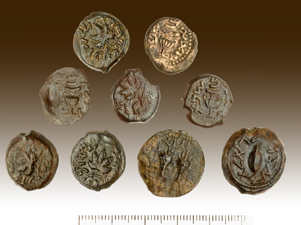
Skyview of the excavation area
During Israel Antiquities Authority excavations at the City of David located inside the Walls around Jerusalem National Park, an impressive and spacious edifice that dates to the end of the Second Temple period was exposed underneath the parking facility known as the “Givati Car Park”. According to the writings of Josephus Flavius the Roman historian, the building that was uncovered was likely erected by the Hadyab family, the most notable member of which is Queen Helena of Adiabene who converted to Judaism, and later lived in Jerusalem and was buried there.
In the Antiquities Authority excavations which are being carried out with the Nature and Parks Authority and the Ir David Foundation, an impressive architectural complex has been partially uncovered that includes massive foundations, walls - some of which are preserved to a height in excess of five meters and made of stones that weigh hundreds of kilograms, halls that are preserved to a height of at least two stories, a basement level that was covered with vaults, remains of polychrome frescoes, water installations and ritual baths (miqve’ot).
Evidence of the drama which transpired within it prior to its destruction by the Romans in the year 70 CE can be seen in the narrow openings that were discovered in the basement level through which its inhabitants attempted to flee. Much of the structure was intentionally demolished at that time: the stones from the walls and the ceilings of the upper stories were discovered mixed inside the destruction layer that accumulated on the floor of the basement. Among the finds recovered are pottery vessels, stone vessels and coins that date to the end of the Second Temple period.

Part of the coins found in the building's basement
The exposure of the remains of such a spacious building as this raises the question regarding its function and identification. According to the excavation director, Dr. Doron Ben-Ami of the Antiquities Authority, the structure, which is an anomaly in the landscape of the Lower City at the end of the Second Temple period, is probably connected to the buildings which the royal family of Adiabene erected there according to the testimony of Josephus. Nonetheless, he notes, “this interpretation of the finds should not be accepted without due reservation and the hope that upon expanding the excavation in coming seasons we will discover finds that will aid in identifying the architectural complex”.
The large edifice was overlain with remains that date to later periods: Byzantine, Roman and Early Islamic, while below it there are remains from the Early Hellenistic period and even artifacts from the time of the First Temple.
Additional Articles ...